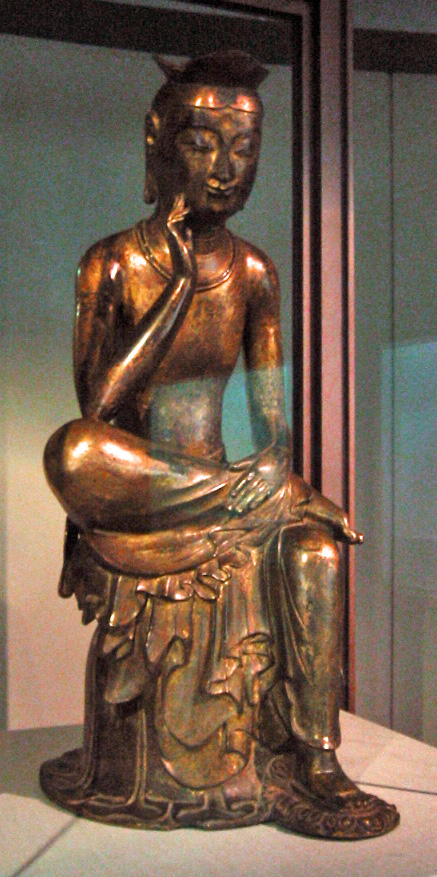- Baekje smile
Infobox Korean name

caption=A smiling "bangasayusang " from Silla or Baekje
hangul=백제인의 미소
hanja=百濟人의 微笑
mr=Paekcheini miso
rr=Baekjeinŭi misoThe Baekje smile is a term art historians use to refer to the common smile motif found inBaekje sculpture and bas-relief. Baekje figures express a unique smile that has been described as both enigmatic and subtle. The smile has been also been characterized in many different ways from "genuinely glowing" to "thin and mild" to "unfathomable and benevolent." [http://www.museeguimet.fr/gb/pages/page_id17980_u1l2.htm] . [http://www.dynamic-korea.com/culture/view.php?main=LEC&uid=200500022289] . [http://www.asianinfo.org/asianinfo/korea/scu/paekche_period.htm] .Of all the Three Kingdoms, Baekje art was stylistically the most realistic and technically sophisticated Fact|date=February 2007. While
Goguryeo sculpture was highly rigid andSilla sculpture was formalized, Baekje sculpture exhibited distinct characteristics of warmth, softness, and used relaxed poses. [http://www.britannica.com/ebi/article-9057960] . Sometimes, the Baekje style has been attributed to influence from the southern Chinese dynasties. [http://www.britannica.com/ebi/article-9057960] . However, the most remarkable feature of Baekje sculpture is the distinctive Baekje smile. [http://www.britannica.com/ebi/article-9057960] . The smile gives the Baekje statues a sense of friendliness and an air of pleasantness that is rarely found in other traditions ofBuddhist sculpture. The smile is considered to be unique and distinctive. [http://www.buddhamuseum.com/korean-buddha.html] .ee also
*
Archaic smile
*List of Korea-related topics
*Baekje
*Korean art External links
* [http://www.britannica.com/ebi/article-9057960] Britannica
* [http://scienceview.berkeley.edu/VI/handbooks_history.html Cultural Development of the Three Kingdoms]
* [http://www.buddhamuseum.com/korean-buddha.html 9th Century Korean Bronze Buddha Shakyamuni]
* [http://www.museeguimet.fr/gb/pages/page_id17980_u1l2.htm Meditating Bodhisattva] – Musée National Des Arts Asiatiques-Guimet
* [http://www.dynamic-korea.com/culture/view.php?main=LEC&uid=200500022289 The Three Kingdoms Period of Korea] – ROK embassy to the US
* [http://www.marymount.k12.ny.us/marynet/TeacherResources/SILK%20ROAD/html/sillajapan.htm Korean Influence on Japanese Culture]
Wikimedia Foundation. 2010.
